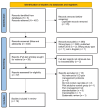Differing Approaches to Pain Management for Intrauterine Device Insertion and Maintenance: A Scoping Review
- PMID: 38586685
- PMCID: PMC10999118
- DOI: 10.7759/cureus.55785
Differing Approaches to Pain Management for Intrauterine Device Insertion and Maintenance: A Scoping Review
Erratum in
-
Correction: Differing Approaches to Pain Management for Intrauterine Device Insertion and Maintenance: A Scoping Review.Cureus. 2025 Sep 25;17(9):c323. doi: 10.7759/cureus.c323. eCollection 2025 Sep. Cureus. 2025. PMID: 41020032 Free PMC article.
Abstract
Intrauterine devices (IUDs) are considered a reliable contraceptive option for women, but they can come with side effects. There is a disconnect in standard guidelines for IUD insertion within and without the U.S. The objective of this review was to address a gap in the literature regarding official procedures for pain management during IUD implantation. This scoping review was initiated using keywords to extract relevant articles from multiple databases: U.S. National Library of Medicine National Institutes of Health (PubMed), MEDLINE (Ovid), and Excerpta Medica dataBASE (EMBASE, Ovid). Initially, 457 articles were identified and after a rigorous screening and selection process, 37 articles were chosen to be further assessed to ascertain if they met the study's inclusion criteria. Those 37 articles were further evaluated fully to check for relevancy. From that process, 19 articles were chosen for the review, and all passed quality assessment evaluations using the JB Appraisal Tools. To best address the research question, the data from the 19 articles were divided into three categories: 1) circumstantial factors, 2) non-pharmacological methods, and 3) pharmacological methods. Circumstantially, women with previous vaginal deliveries experienced the lowest pain during the procedure, and nulligravid (never pregnant) women experienced the most pain. Lower pain scores were reported by lactating women compared to non-lactating. Black women experienced the most anticipated pain compared to other races. Regarding non-pharmacological methods, different insertion techniques, tools, and the use of a cold compress were found to not affect the level of pain during IUD insertion. Lastly, it was shown that pharmacological methods such as lidocaine gel, lidocaine paracervical block, and lidocaine combined with either diclofenac or prilocaine decreased pain scores at different time stamps of the procedure. Also, oral ketorolac and a vaginal combination of misoprostol and dinoprostone helped reduce pain. Findings from this scoping review revealed a lack of uniformity across practices when performing IUD insertions, possibly due to differences in procedures across circumstantial factors, non-pharmacological methods, and pharmacological methods. More research is needed to investigate the intricacies of pain with IUD insertion. Moving forward, especially following a potential increase in the use of IUDs after the reversal of Roe v. Wade, establishing this gap may lead to a more refined standardized protocol to mitigate pain with IUD insertions.
Keywords: intrauterine devices (iud); non-pharmacological treatments; pharmacological treatment; treatment guidelines; women's reproduction.
Copyright © 2024, Rahman et al.
Conflict of interest statement
The authors have declared that no competing interests exist.
Figures
References
-
- The comeback of the IUD in twenty-first century USA. Watkins ES. J Hist Med Allied Sci. 2021;76:191–216. - PubMed
-
- Practice Bulletin No. 186 summary: long-acting reversible contraception: implants and intrauterine devices. Obstet Gynecol. 2017;130:1173–1175. - PubMed
-
- Young women's attitudes towards, and experiences of, long-acting reversible contraceptives. Bracken J, Graham CA. Eur J Contracept Reprod Health Care. 2014;19:276–284. - PubMed
Publication types
LinkOut - more resources
Full Text Sources
Medical
Miscellaneous

